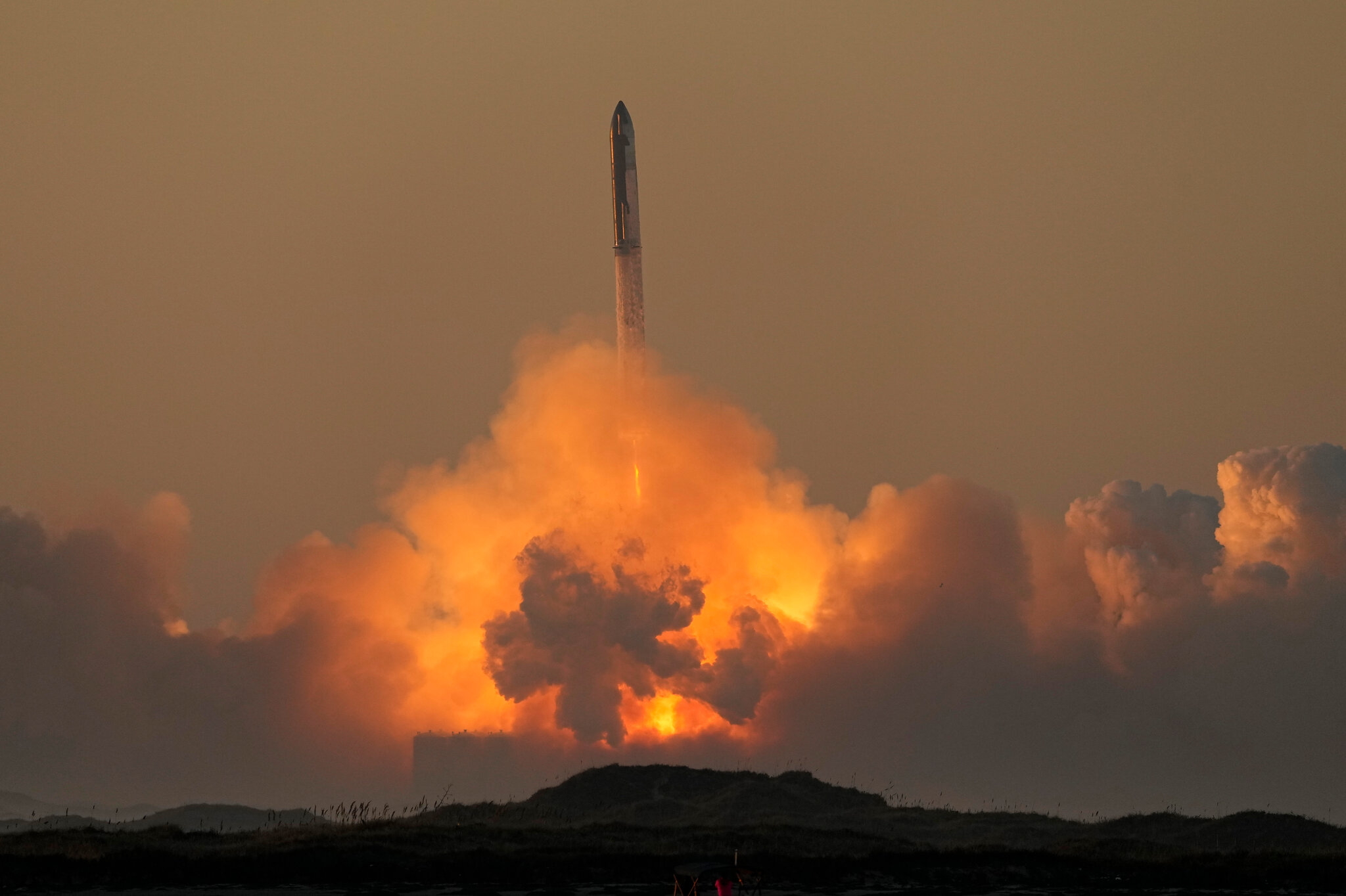SpaceX’s Starship Launch Marks Huge Step Toward Mars, Elon Musk’s Vision Comes Closer

SpaceX’s Starship Launch Marks Huge Step Toward Mars, Elon Musk’s Vision Comes Closer
In a groundbreaking moment for space exploration, SpaceX has successfully launched its highly anticipated Starship, marking a significant milestone in the company’s ambitious mission to make life multiplanetary. The launch is a crucial step in Elon Musk’s long-held vision of sending humans to Mars, opening up the possibility of interplanetary travel and setting the stage for what could be humanity’s next great leap into the cosmos. Musk, who has repeatedly emphasized his goal of reducing the cost of space travel and making space more accessible, has once again proven that his visionary plans are much closer to becoming a reality.
The Starship, SpaceX’s fully reusable spacecraft, has been years in development, and its successful launch is a testament to the company’s relentless pursuit of innovation. With its massive payload capacity, advanced technology, and focus on sustainability, Starship is designed not only to carry humans to Mars but to revolutionize the future of space travel. The significance of this launch cannot be overstated, as it brings humanity one step closer to what was once thought to be science fiction—establishing a permanent human presence on Mars.
The Starship: A New Era of Space Travel
SpaceX’s Starship is no ordinary spacecraft; it is a symbol of the future of interplanetary travel. With a height of over 120 meters, Starship is designed to be the largest and most powerful rocket ever built. The spacecraft will play a central role in Musk’s vision of reducing the cost of space travel by making launches fully reusable. Unlike traditional rockets, which are discarded after use, Starship’s design allows it to be reused for multiple flights, significantly lowering the cost of sending humans and cargo into space.
Starship is capable of carrying up to 100 passengers, making it ideal for missions to the Moon, Mars, and potentially beyond. The spacecraft’s large cargo hold also opens up the possibility of sending massive amounts of equipment and resources to other planets, a crucial component of establishing permanent colonies on Mars. The launch system comprises two main parts: the Super Heavy booster, which provides the initial lift-off, and the Starship spacecraft, which is capable of carrying humans and payloads into orbit and beyond.
The successful launch of Starship is a major achievement not only for SpaceX but for the entire space industry. The vehicle is designed to be fully integrated into SpaceX’s broader goals of space exploration, which include returning humans to the Moon through NASA’s Artemis program, establishing a sustainable human presence on Mars, and facilitating space tourism. Starship’s massive payload capacity and reusability make it the ideal candidate for these future missions, opening up a new era of possibilities for space travel.
Elon Musk’s Vision for Mars
Elon Musk’s dream of colonizing Mars has been the driving force behind much of SpaceX’s development over the past decade. Musk has repeatedly stated that making life multiplanetary is essential for the long-term survival of humanity. He believes that establishing a permanent, self-sustaining human settlement on Mars will provide a “plan B” for humanity in case of catastrophic events on Earth, such as climate change, pandemics, or other existential threats.
For Musk, Mars represents more than just a new frontier—it is a crucial step in ensuring the survival of human civilization. By sending people to Mars, SpaceX aims to demonstrate that humanity can thrive beyond Earth and open the door for other nations and companies to follow suit. Musk has outlined a vision for a city on Mars, with plans to build the infrastructure necessary to support human life, including habitats, energy systems, and food production.
The key to making this vision a reality is lowering the cost of space travel, which is one of the main goals of SpaceX. Musk has stressed that by developing reusable rockets and reducing the cost per launch, he can make it economically feasible to send humans to Mars and establish a sustainable colony. The Starship is at the heart of this strategy, as its reusability is designed to make each launch more affordable, ultimately making space exploration and interplanetary travel accessible to a larger number of people and organizations.
Musk envisions a future where millions of people could live and work on Mars, creating a thriving, self-sustaining society that could serve as a backup for humanity. This vision, while still years or even decades away from becoming a reality, is moving closer with each successful test and launch of Starship. The successful launch is not only a triumph of engineering but also a sign that Musk’s vision of a multiplanetary future is within reach.
Challenges Ahead: The Road to Mars
While the successful Starship launch is a massive achievement, the road to Mars is far from smooth. Several challenges remain before humans can set foot on the Red Planet and begin the process of colonization. Some of the key hurdles include:
1. Life Support Systems:
One of the most significant challenges in sending humans to Mars is ensuring that astronauts can survive the harsh conditions of the planet. Mars is inhospitable to human life, with a thin atmosphere, extreme temperatures, and high levels of radiation. For a Mars mission to succeed, SpaceX will need to develop advanced life support systems capable of providing astronauts with breathable air, water, food, and shelter for extended periods of time.
2. Radiation Protection:
Mars’ thin atmosphere offers little protection from cosmic radiation, which can pose serious health risks to astronauts over long periods. Musk has acknowledged that one of the biggest challenges of a Mars mission will be shielding astronauts from radiation. SpaceX is exploring various solutions, such as using the spacecraft’s own structure or creating underground habitats, to protect crew members from radiation exposure.
3. Propulsion and Fuel:
While Starship is designed to be powered by methane, one of the significant obstacles for a Mars mission is fuel production. Musk has proposed the idea of creating fuel on Mars itself by extracting methane from the planet’s carbon dioxide-rich atmosphere, a process known as in-situ resource utilization (ISRU). However, developing the technology to produce enough fuel for return trips to Earth is still a long-term challenge that will need to be solved.
4. Psychological and Physical Well-being of Astronauts:
A journey to Mars could take months, or even years, depending on the timing of the launch and return. During this time, astronauts will be isolated from Earth, with limited communication with loved ones and the outside world. Ensuring the mental and physical well-being of crew members will be essential for the success of Mars missions. SpaceX will need to design habitats that provide both the privacy and community needed to maintain a healthy and functional crew.
5. Infrastructure on Mars:
Once on Mars, the next major challenge will be creating the infrastructure needed to support human life. This includes habitats, water extraction, energy production, and sustainable agriculture. Musk’s vision involves building self-sustaining cities that can produce their own energy and food, but this will require significant technological breakthroughs, as well as investments in research and development.
A New Era for Space Exploration
Elon Musk’s vision of a future where humanity lives on Mars is becoming more achievable with every passing day. The successful launch of SpaceX’s Starship is a monumental step forward in making interplanetary travel a reality. While significant challenges remain, Musk’s relentless pursuit of innovation and his ability to make the seemingly impossible possible continue to drive SpaceX’s success.
The launch is not just a victory for Musk or SpaceX—it is a victory for humanity. It brings us closer to the realization that space exploration is not confined to the realm of science fiction but is within our reach. The dream of becoming a multiplanetary species may seem distant, but with each successful test flight and technological advancement, it becomes more tangible.
As Musk has said, humanity’s future lies beyond Earth. SpaceX’s Starship is not just a spacecraft—it is a symbol of that future, a future where humans are not limited by the boundaries of our home planet but are free to explore and settle the stars. The journey to Mars may still be in its early stages, but thanks to SpaceX and Elon Musk’s unwavering vision, humanity is one step closer to making life on Mars a reality.








